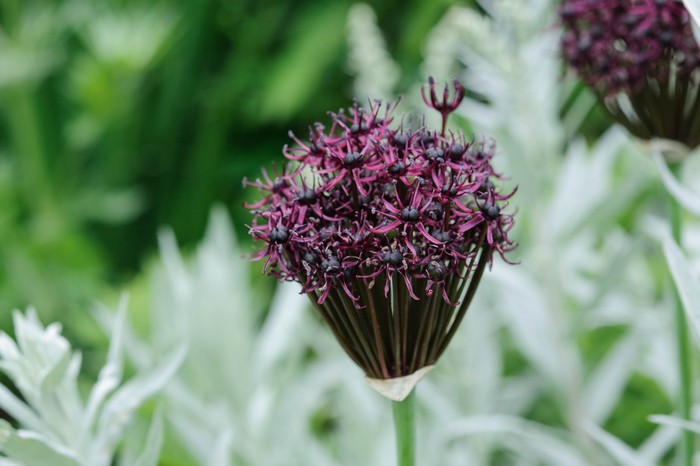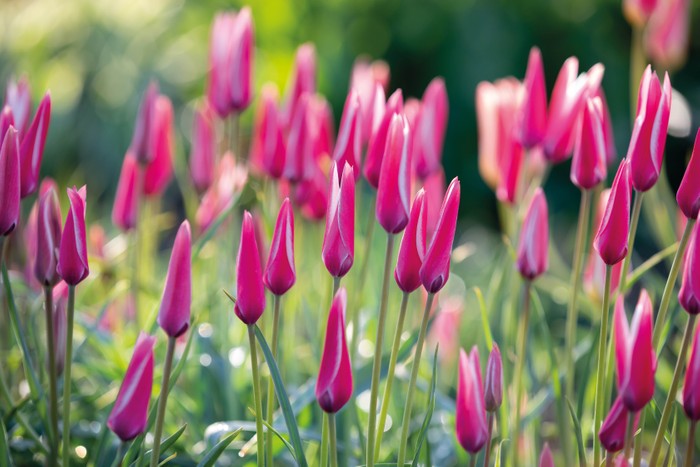
Plants for full sun
As temperatures and climates change, the need to grow resilient plants is a necessity for every gardener. Here expert plantsman and landscape designer Cassian Schmidt picks out his top choices of plants for dry, sunny areas in the garden.
At Hermannshof botanical garden, we use the German system of garden habitats to select plants according to their habitat requirements, sociability and aesthetic qualities. This is essential to achieve long-term, ecologically balanced and low-maintenance horticultural plant communities in gardens and urban green spaces. Below is my choice of plants that will be perfect for dry and sunny parts of the garden.

Key: H = height; S = spread; C = conditions; SI = season of interest; HR = hardiness rating.
Plants for full sun
Allium atropurpureum

Multi-flowering, semi-globose clusters of deep burgundy-red florets. Perfect for steppe plantings with salvias and ornamental grasses. Self-seeds if conditions are right. H 80cm. S 10cm. C Rich, medium-dry, well-drained soil; full sun. SI Early summer. HR RHS H5, USDA 4a-7b.
Allium 'Forelock'
One of my favourite alliums for open Mediterranean and steppe plantings. Elegant, deep-purple drumsticks with contrasting white stamens on tall stems, moving slightly in the wind. Good self-seeder. H 1.6m. S 8cm. C Rich, medium-dry, well-drained soil; full sun. SI Early summer. HR RHS H5, USDA 4a-8b.
Allium 'Summer Drummer'
A spectacular Mediterranean species. Sends out tall, purple- mauve drumsticks in midsummer. Plants send out their new fans of chive-like leaves in September, overwintering fully green. Small groups look dramatic in open steppe plantings. H 1.8m. S 20cm. C Rich, medium-dry, well-drained loam; full sun. SI July – August. HR RHS H5, USDA 7a-10a.
Asclepias tuberosa

A drought-tolerant prairie plant, thriving even in poor, sandy or gravelly soils. Bright-orange flowers in June, followed by interesting seedheads in August to September. Attracts butterflies. H 80cm. S 60cm. C Light, well-drained soil; full sun. SI June – July. HR RHS H4, USDA 3a-9b.
x Chitalpa tashkentensis
A small, deciduous tree with a beautiful open shape, willow-like leaves, covered with clusters of large, deep-pink flowers from June to August. Adapted to low humidity and summer drought. H 3.5-4.5m. S 3.5m. C Moist to dry loam, well-drained soil; full sun. SI June – July. HR RHS H4, USDA 7a-11.
Watch Cassian Schmidt deliver the winter lecture at the New York Botanical Garden
Echinacea pallida 'Hula Dancer'

An elegant seed strain of this familiar prairie plant with almost pure-white, drooping rays, arranged around an eye-catching greenish cone. Attractive seedheads from August to January. H 80-90cm. S 20cm. C Light, well-drained soil; full sun. SI June – July. HR RHS H5, USDA 3a-8b.
Echinacea paradoxa

A coneflower with unusual, golden-yellow, drooping ray flowers. If planted in dry conditions on well-drained soils, can be very long-lived. Sensitive to competition, so best planted together with low, clump-forming prairie grasses in low density. H 70-80cm. S 20cm. C Light, well-drained soil; full sun. SI June – July. HR RHS H5, USDA 5a-8b.
Euphorbia nicaeensis

A low-growing, Mediterranean sub-shrub with attractive, evergreen, bluish-green leaves and large, acid-yellow flowers over a long period. When planted on lean, gravelly soils, the bracts have an intense red colouration in August and September. Perfect for gravel gardens. H 30-40cm. S 25cm. C Light, well-drained, dry soil; full sun. SI June – August. HR RHS H5, USDA 6a-10a.
Genista aetnensis
An elegant large shrub or small tree with broom-like slender branches, which are covered with small, yellow, pea-like flowers in early June. Well adapted to summer drought and surprisingly hardy. AGM. H 2.5-3.5m. S 1.5m. C Well-drained, gravelly soil; full sun. SI June – October. HR RHS H5, USDA 6a-9b.
Geranium sanguineum 'Album'
One of the best European hardy geraniums for dry conditions in full sun or the sunny woodland margin. Works well when dotted through naturalistic mixed perennial plantings, but also in groups at the front of a border. A sterile selection that doesn’t seed around like the magenta wild form. AGM. H 40cm. S 50cm. C Well-drained loam, chalk; full sun to light shade. SI May – June. HR RHS H7, USDA 4a-8b.
Linum narbonense

Small, evergreen sub-shrub, native to the southern Mediterranean. Its large, clear-blue flowers stay open all day, unlike Linum perenne, which drops its petals before midday. Best used among other drought-tolerant, delicate perennials and airy grasses. H 60cm. S 15cm. C Light, well-drained soil, prefers chalk; full sun. SI May – June. HR RHS H4, USDA 6a-10a.
Monarda bradburyana 'Ozark'
A selection I introduced in 2004. Native to dry woodlands and glades in the Ozarks, it prefers sun, but can tolerate light shade. Shiny foliage emerges dark-purple in spring. Flowers early, and looks good in a prairie setting with grasses. H 60cm. S 50cm. C Well-drained soil; full sun or part shade. SI May – June. HR RHS H5, USDA 5a-8b.
Phlomis bourgaei
I first fell in love with this evergreen, yellowish-grey-leaved sub-shrub on a hike in southwestern Turkey, when I saw it covered with large golden-yellow flowers. A perfect addition to any garrigue-like planting or gravel garden. Best planted in a sheltered, summer-dry spot. H 80cm-1.2m. S 70cm. C Dry, gravelly soil; full sun. SI October – November. HR RHS H5, USDA 7a-11.
Ruella humilis
A useful, low-growing companion perennial for dry, prairie plantings, best scattered into a matrix of low-growing, warm-season grasses, such as Bouteloua. Large petunia-like blue flowers from June to August. H 25-35cm. S 30cm. C Dry, well-drained soil; full sun to light shade. SI June – August. HR USDA 4a-8b.
Sesleria argentea

Seslerias are the best semi-evergreen grasses for matrix plantings or intermingled in mixed plantings. This little-known species grows in rocky areas or in the dappled shade of open oak forest. Silvery flower spikes in summer. H 35cm. S 35cm. C Mesic to dry, well-drained loam; full sun to part shade. SI May – October. HR RHS H7, USDA 5b-8b.
Sesleria 'Greenlee'
A low-growing hybrid of Sesleria autumnalis. Well-behaved semi-evergreen cool-season grass, is useful as a ground cover matrix or understorey, and for planting through. Mid-green spring foliage is joined in summer by airy flower spikes. H 35cm. S 35cm. C Mesic to dry, well-drained soil; full sun to part shade.
Sporobolus heterolephis 'Odorous Cloud'
Fine, arching foliage and diffuse clouds of airy flowers shimmer on this grass that looks great with echinacea seedheads. Orange-yellow autumn colour. H 70cm. S 50cm. C Medium-dry, well-drained chalk, loam, sand; full sun. SI Flowers August – September. HR RHS H7, USDA 3a-9b.
Symphyotrichon oblongifolium 'October Skies'
A robust, mildew-free aster from the midwestern prairies. The large blue flowers cover the plants for several weeks from late September until mid November. H 55-70cm. S 60cm. C Mesic to dry, well-drained soil; full sun. SI October – November. HR RHS H7, USDA 3a-8a.
Tulipa 'Honky Tonk'
A lovely tulip with slightly pointed, sulphur-yellow flowers. Best in small groups of 10-15 bulbs. Looks good with Euphorbia cyparissias in low steppe plantings. H 25cm. S 5cm. C Medium-dry, well-drained soil; full sun. SI Spring. HR RHS H6, USDA 5a-8b.
Tulipa 'Ice Stick'
One of the earliest and most persistent tulips for rock gardens or for planting around the base of deciduous shrubs and small trees, where it appreciates the summer drought. H 20cm. S 5cm. C Rich, medium-dry, well-drained soil; full sun to light shade. SI Spring. HR RHS H6, USDA 5a-8b.
Tulipa orphanidea Whittallii Group

A wonderful, warm orange-red species tulip. As in woodland grass, with elegant arching leaves that many species-like tulips, the elegant flowers need sunlight to open fully and to glow from backlight. AGM. H 20cm. S 5cm. C Medium-dry, well-drained a lighter green in summer. Beautiful on the soils (needs summer drought); full sun. SI Spring. HR RHS H6, USDA 5a-8b.
Tulipa 'Peppermintstick'

A super-elegant species tulip for rock gardens and low steppe plantings among grasses. Bi-colour white and red flowers in late April. Scatter bulbs or plant in small groups. H 25cm. S 5cm. C Medium dry, well-drained soils (needs summer drought); full sun. SI Spring. HR RHS H6, USDA 5a-8b.
Tulipa praestans 'Van Tubergens Variety'
A wonderful, multi-flowered, warm-red species-like tulip. Quite adaptable to different soil conditions. Looks stunning together with blue or white Anemone blanda. H 30cm. S 8cm. C Rich, medium-dry, well-drained soil; full sun to light shade. SI Spring. HR RHS H6, USDA 5a-8b.
Authors
Cassian Schmidt is a landscape designer, plantsman, author, professor and lecturer, and one of the foremost practitioners of the New German Style. He is currently director of Hermannshof, a botanical trial garden in Weinheim, Germany, known for its habitat-based approach to planting design.

Niwaki bundle worth £57 when you subscribe
Subscribe to Gardens Illustrated magazine and claim your Niwaki bundle worth £57
*UK only

Container Gardening Special Edition
The Gardens Illustrated Guide to Container Gardening.
In this special edition, discover colourful flower combinations and seasonal planting schemes for pots designed by leading plantspeople, and essential know-how for container gardening success. Just £9.99 inc UK p&pBy entering your details, you are agreeing to our terms and conditions and privacy policy. You can unsubscribe at any time.

Gardens of the Globe
From botanical wonders in Australia to tranquil havens closer to home in Ireland, let this guide help you to discover some of the most glorious gardens around the world
By entering your details, you are agreeing to our terms and conditions and privacy policy. You can unsubscribe at any time.




